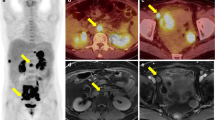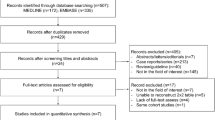Abstract
Purpose
Uterine carcinosarcomas clinically confined to the uterus usually harbor occult metastases. We conducted a pilot study to evaluate the value of 18F-fluorodeoxyglucose (FDG) positron emission tomography (PET) in uterine carcinosarcoma.
Methods
Patients with histologically confirmed uterine carcinosarcoma were enrolled. Abdominal and pelvic magnetic resonance imaging (MRI)/whole-body computed tomography (CT) scan, and whole-body 18F-FDG PET or PET/CT were undertaken for primary staging, evaluating response, and restaging/post-therapy surveillance. The clinical impact of 18F-FDG PET was determined on a scan basis.
Results
A total of 19 patients were recruited and 31 18F-FDG PET scans (including 8 scans performed on a PET/CT scanner) were performed. Positive impacts of scans were found in 36.8% (7/19) for primary staging, 66.7% (2/3) for monitoring response, and 11.1% (1/9) for restaging/post-therapy surveillance. PET excluded falsely inoperable disease defined by MRI in two patients. Aggressive treatment applying to three patients with PET-defined resectable stage IVB disease seemed futile. Two patients died of disease shortly after salvage therapy restaged by PET. With PET monitoring, one stage IVB patient treated by targeted therapy only was alive with good performance. Using PET did not lead to improvement of overall survival of this series compared with the historical control (n = 35) (P = 0.779).
Conclusions
The preliminary results suggest that 18F-FDG PET is beneficial in excluding falsely inoperable disease for curative therapy and in making a decision on palliation for better quality of life instead of aggressive treatment under the guidance of PET. PET seems to have limited value in post-therapy surveillance or restaging after failure.


Similar content being viewed by others
References
Amant F, Cardron I, Fuso L, Berteloot P, de Jonge E, Jacomen G, et al. Endometrial carcinosarcomas have a different prognosis and pattern of spread compared to high-risk epithelial endometrial cancer. Gynecol Oncol 2005;98:274–80.
Major FJ, Blessing JA, Silverberg SG, Morrow CP, Creasman WT, Currie JL, et al. Prognostic factors in early-stage uterine sarcoma. A Gynecologic Oncology Group study. Cancer 1993;71 Suppl:1702–09.
Yamada SD, Burger RA, Brewster WR, Anton D, Kohler MF, Monk BJ. Pathologic variables and adjuvant therapy as predictors of recurrence and survival for patients with surgically evaluated carcinosarcoma of the uterus. Cancer 2000;88:2782–86.
Sartori E, Bazzurini L, Gadducci A, Landoni F, Lissoni A, Maqqino T, et al. Carcinosarcomas of the uterus: a clinicopathological multicenter CTF study. Gynecol Oncol 1997;67:70–5.
Inthasorn P, Carter J, Valmadre S, Beale P, Russell P, Dalrymple C. Analysis of clinicopathologic factors in malignant mixed Müllerian tumors of the uterine corpus. Int J Gynecol Cancer 2002;12:348–53.
Silverberg SG, Major FJ, Blessing JA, Fetter B, Askin FB, Liao SY, et al. Carcinosarcoma (malignant mixed mesodermal tumor) of the uterus. A Gynecologic Oncology Group pathologic study of 203 cases. Int J Gynecol Pathol 1990;9:1–19.
Ohguri T, Aoki T, Watanabe H, Nakamura K, Nakata H, Matsuura Y, et al. MRI finding including gadolinium-enhanced dynamic studies of malignant, mixed mesodermal tumors of the uterus: differentiation from endometrial carcinomas. Eur Radiol 2002;12:2737–42.
Hopper KD, Singapuri K, Finkel A. Body CT and oncologic imaging. Radiology 2000;215:27–40.
Gambhir SS, Czenin J, Schwimmer J, Silverman DH, Coleman RE, Phelps ME. A tabulated summary of the FDG PET literature. J Nucl Med 2001;42:1S–93S.
Yen TC, Ng KK, Ma SY, Chou HH, Tsai CS, Hsueh S, et al. Value of dual-phase 2-fluoro-2-deoxy-d-glucose positron emission tomography in cervical cancer. J Clin Oncol 2003;21:3651–8.
Chang TC, Law KS, Hong JH, Lai CH, Yen TC, Ng KK, et al. Positron emission tomography for unexplained serum SCC-Ag elevation in cervical cancer patients—a phase II study. Cancer 2004;101:164–71.
Tsai CS, Chang TC, Lai CH, Tsai CC, Ng KK, Hsueh S, et al. Preliminary report of using FDG-PET to detect extrapelvic lesions in cervical cancer patients with enlarged pelvic lymph nodes on MRI/CT. Int J Radiat Oncol Biol Phys 2004;58:1506–12.
Chao A, Chang TC, Ng KK, Hsueh S, Huang HJ, Chou HH, et al. 18-F FDG PET in the management of endometrial cancer. Eur J Nucl Med Mol Imaging 2006;33:36–44.
Umesaki N, Tanaka T, Miyama M, Oqita S, Ochi H. Combined diagnostic imaging of uterine carcinosarcoma: a case report. Int J Gynecol Cancer 2000;10:425–8.
Umesaki N, Tanaka T, Miyama M, Kawamura N, Oqita S, Kawabe J, et al. Positron emission tomography with (18)F-fluorodeoxyglucose of uterine sarcoma: a comparison with magnetic resonance imaging and power Doppler imaging. Gynecol Oncol 2001;80:372–7.
Torizuka T, Kanno T, Futatsubashi M, Okada H, Yoshikawa E, Nakamura F, et al. Imaging of gynecologic tumors: comparison of 11C-choline PET with 18F-FDG PET. J Nucl Med 2003;44:1051–6.
Nieves-Lugo L, Blanch R, Abad M, Lilue M, Gomez C, Colmenter L, et al. Uterine carcinosarcoma arising from an endometrial polyp. Assessment by 3-dimensional power Doppler angiography and positron emission tomography/computed tomography. J Ultrasound Med 2006;25:675–8.
Murakami M, Tsukada H, Shida M, Watanabe M, Maeda H, Koido S, et al. Whole-body positron emission tomography with F-18 fluorodeoxyglucose for the detection of recurrence in uterine sarcomas. Int J Gynecol Cancer 2006;16:854–60.
Lai CH, Huang HJ. The role of hormones for the treatment of endometrial hyperplasia and endometrial cancer. Curr Opin Obstet Gynecol 2006;18:29–34.
Sutton G, Brunett VL, Kilgore L, Soper JT, McGehee R, Olt G, et al. A phase III trial of ifosfamide with or without cisplatin in carcinosarcoma of the uterus: a Gynecologic Oncology Group study. Gynecol Oncol 2000;79:147–53.
Ansink AC, Cross PA, Scorer P, de Barros Lopes A, Monaqhan JM. The hormone receptor status of uterine carcinosarcomas (mixed mullerian tumours): an immunohistochemical study. J Clin Pathol 1997;50:328–31.
Curtin JP, Blessing JA, Soper JT, DeGeest K. Paclitaxel in the treatment of carcinosarcoma of the uterus: a Gynecologic Oncology Group study. Gynecol Oncol 2001;83:268–70.
Menczer J, Levy T, Piura B, Chetrit A, Altaras M, Meriovitz M, et al. A comparison between different postoperative treatment modalities of uterine carcinosarcoma. Gynecol Oncol 2005;97:166–70.
Callister M, Ramondetta LM, Jhingran A, Burke TW, Eifel PJ. Malignant mixed Müllerian tumors of the uterus: analysis of patterns of failure, prognostic factors, and treatment outcome. Int J Radiat Oncol Biol Phys 2004;58:786–96.
Rose PG, Piver MS, Tsukada Y, Lau T. Patterns of metastasis in uterine sarcoma. An autopsy study. Cancer 1989;63:935–8.
Ansink AC, Cross PA, Scorer P, de Barros Lopes A, Monaghan JM. The hormonal receptor status of uterine carcinosarcomas (mixed müllerian tumours): an immunohistochemical study. J Clin Pathol 1997:50:328–31.
Raspollini MR, Susini T, Amunni G, Paglierani M, Taddei A, Marchionni M, et al. COX-2, c-KIT and HER-2/neu expression in uterine carcinosarcomas: prognostic factors or potential markers for targeted therapies? Gynecol Oncol 2005;96:159–67.
Winter WE, Seidman JD, Krivak TC, Chauhan S, Carlson JW, Rose GS, et al. Clinicopathological analysis of c-kit expression in carcinosarcomas and leiomyosarcomas of the uterine corpus. Gynecol Oncol 2003;91:3–8.
Fayette J, Ray-Coquard I, Bompas E, Zufferey L, Tabone-Eglinger S, Ranchère D, et al. Aromatase inhibitors (AI) are highly effective in uterine sarcomas (US) expressing estrogen receptors. J Clin Oncol (Meeting Abstracts) 2006;24:9576.
Acknowledgments
Supported by research grants from Chang Gung Memorial Hospital (CMRPG340011 and CMRP340081).
Author information
Authors and Affiliations
Corresponding author
Rights and permissions
About this article
Cite this article
Ho, KC., Lai, CH., Wu, TI. et al. 18F-fluorodeoxyglucose positron emission tomography in uterine carcinosarcoma. Eur J Nucl Med Mol Imaging 35, 484–492 (2008). https://doi.org/10.1007/s00259-007-0533-z
Received:
Accepted:
Published:
Issue Date:
DOI: https://doi.org/10.1007/s00259-007-0533-z




